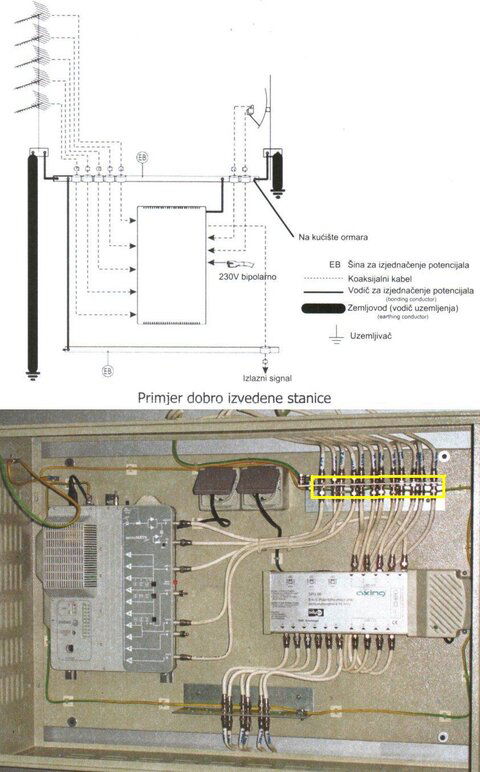Lightning - From Three Directions
foxracing,
Shame on you for not abiding by those totally inappropriate Codes, with their inadequate parts requirements.


There are three types of Strike...
1) A Direct Strike to your Dish/Antenna:
breaker1nine hit it pretty much on the head "all of the electronics still get fried".
With this type strike, there's hardly anything you can do to protect yourself and your equipment, other than spending thousands of dollars on a major Protection System.
You don't have a single piece of wire in your house, which is large enough to carry the Current from a Direct Strike, and if one hits, there is a great possibility of fire, and some physical shock, just cause you're there, regardless of where in the house.
Arrestors are the item to use here, are usually destroyed, and "may" provide you with some reasonable protection.
2) A Strike on the Power Line, somewhere else away from your house.
In this case, the Grounding of your Antenna/System is not all that big of an issue.
I still support System Grounding, but, the "danger" here is coming in through your Electrical Power Supply Lines, and, the best way to treat that situation, is at the Entry Box.
Westinghouse, Federal, Square-D and others, make a Surge Protector which mounts directly into your Box, just like a 220v Breaker. Using one of these catches the surge before it enters ANY circuit of your house. Keep in mind, your Sat/OTA stuff is not the only vulnerable equipment you have.
Though these items are sorta pricey ($75-$150) they are much more maintenance free, and come with an Insurance Policy as B19 has mentioned.
Individual Surge Protectors may used in this case, but, you may have to use several, to cover the equipment you have.
A well maintained Ground Rod for your Household Electrical System, is very necessary here !
3) A Strike near/in your area where the EMF is delivered through Free Air.
NOW, here's where you really need to ground your system !
If you don't give the voltage somewhere to go, it has no choice but to be carried via the Center Conductor and Shield of the Coax, directly down and into your stuff !
Agreed, that this supply of voltage is limited to your Sat or OTA equipment, but, who wants to replace that stuff, when a moderate amount of trouble and parts, should shunt the overage to ground.
Ground or Suppressor Blocks can be used outside, but the best place for the Suppression, is directly on the input "F" connector of the equipment. You thusly use the attenuation of the Coax, to reduce the load as it feeds in.
The difference between Grounding Bocks and Surge/Arrest Blocks/Modules.
Now, you can use both or all, but keep in mind that any "Suppressor", or "Attenuator" MUST have a physical connection to the Center Conductor of your down-lead, and in doing that, pulls off a little to a lot of your Signal Strength.
Ground Blocks are virtually free of any impedance to your Signal, they ground the Shield only.
Concerning that "Black Streak" down the side of your house that B19 mentioned.
This is going to seem like a "over kill", but, here's one way to deal with the Ground Wire when it's necessary to run it down the side of your house.
(This generally applies to Mast/Pole Mounts, but can be applied to Roof-mounts)
As your Antenna Down Lead arrives at the Eave of your house.
Use a Ground/Surge/Arrestor Block, your choice.
Allow a nice gentle Drip Loop of the Coax, and enter your house with that.
Install a Metal Electrical Conduit to take the Ground Wire from the Eave down below any flammable material. Just attach it to your House, DON'T ground it, it should be "free" from any contact which would influence the charge of voltage.
Use a Jacketed Wire (8ga or whatever is required) from the Block, into and down through the Conduit, and then out to the Ground Rod.
The Conduit could be 3/8" or 1/2" with some standard Mounting Clamps, or even a piece of Schedule 40 Pipe will do (kinda ugly though). But anything that will contain the molten copper, when a Direct Strike occurs.
The use of a Jacketed Wire, prevents the Conduit from being involved in the Ground Circuit, and allows time for the Strike Voltage to go to Zero, before the Copper melts.
We're only dealing with a couple nS here.
Z06_Pilot,
Sounds like you did a great job on your system.
Have a good Day !

S.W.


